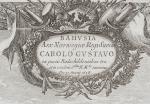[Pufendorf, BAHVSIA Arx Norwegiae Regi Suecia CAROLO GUSTAVO ex pactis Rodschild
BAHVSIA Arx Norwegiae Regi Suecia CAROLO GUSTAVO ex pactis Rodschildensibus traetin enandem …/ Die 30. Martij 1658.
Original copper engraving from Pufendorf’s “De rebus a Carolo Gustavo”, this being Plate No.80 with an inset map of the border-region between Sweden and Norway at the end of the 17th century. Nuremberg, Christoph Riegel, 1696. Beautifully Framed. Size of frame with the copper engraving: 54.5 cm x 45.5 cm. Size of the actual engraving: c. 44 cm x 35.5 cm. Excellent condition.
Bohus Fortress (also known as Baahus or Båhus, originally: Bágahús) lies along the old Norwegian–Swedish border in Kungälv, Bohuslän, Sweden, north east from Hisingen where the Göta river splits into two branches (20 km (12 mi) north of Gothenburg). It commands the surrounding area from a cliff 40 m (130 ft) high, with the river forming a natural moat around it.
The fortress was attacked or besieged 14 times, but was never captured. During the Northern Seven Years’ War, in 1563–1570, it was seriously damaged. This occurred in 1566, when 250 Swedish soldiers successfully stormed the northeastern-most tower. The Norwegian commander sent in a volunteer to blow up the ammunition stores underneath the tower, killing the Swedes and repelling the attack. As a reward the family of the volunteer got a piece of land which is still owned by the descendants of this volunteer.
The Norwegians rebuilt the fortress of stone and brick, and reinforced it substantially. The reconstruction immediately after the war was directed by Hans Paaske (Påske) from the Netherlands.
In 1593–1604, similar to the construction then undertaken at Akershus in Oslo, Bohus was upgraded to a bastion fortress. A new outer fortification was raised. This construction was one of the early works of Hans van Steenwinckel, also from the Netherlands, who later became noted for his Dutch Renaissance style design in Denmark.
As Swedish invasions continuously threatened Norwegian Båhuslen during this time period, the improvement of the fortifications went on for years. For example, starting in the summer of 1651 and until the autumn of 1652, the Dutch engineer Isaac van Geelkerck supervised the construction of two corner towers along the south façade and a new ring wall that was constructed around the arsenal building. Under the terms of the Treaty of Roskilde in 1658, Denmark–Norway ceded the Danish provinces of Scania, Blekinge and Halland (the latter was agreed to belong to Sweden for a period of 30 years after the Peace of Brömsebro, but was given to Sweden permanently in the treaty of Roskilde) and the Norwegian provinces Trøndelag and Bohuslän (including the Bohus Fortress).
After Denmark–Norway ceded the territory which included Bohus Fortress, Fredriksten Fortress was constructed in Fredrikshald on the newly established Norwegian-Swedish border.
Since the Bohus Fortress no longer lay on the border, it was of small use to Sweden, which relied on the existing Älvsborg fortress at Gothenburg and the new Carlsten Fortress built at Marstrand. Instead the fortress was used as a prison. The most noted prisoner was the radical pietist Thomas Leopold, who spent 42 years of his life behind bars, 32 of those at Bohus, for his alleged heresies. His stone-clad cell still exists in the castle. At the end of the 18th century it was decided that the now unused fortress should be demolished. Demolition crews worked at the fortress for two months, after that the money allocated for the job had run out. Residents of the nearby town of Kungälv used the dressed stone from the fortress to build houses. However, much of the fortress is still intact, including the large northern tower, Fars hatt (″Father’s hat”). As of 2015, the fortress is a museum open to visitors during summer. (Wikipedia)
- Keywords: 17th Century · 17th Century Map · Bohus Fortress · Carl Gustav of Sweden · Catalogue Four – International Art · Copper Engraving · Kupferstich · Maps of Norway · Norway · Original Decorative Art Rare · Pufendorf, Samuel von · Rare Map – Norway · Rare Map – Scandinavia · Scandinavia · Scandinavian History · Swedish Wars · Travel Scandinavia – Rare
- Inventory Number: 100014AG
EUR 225,--
© 2025 Inanna Rare Books Ltd. | Powered by HESCOM-Software















